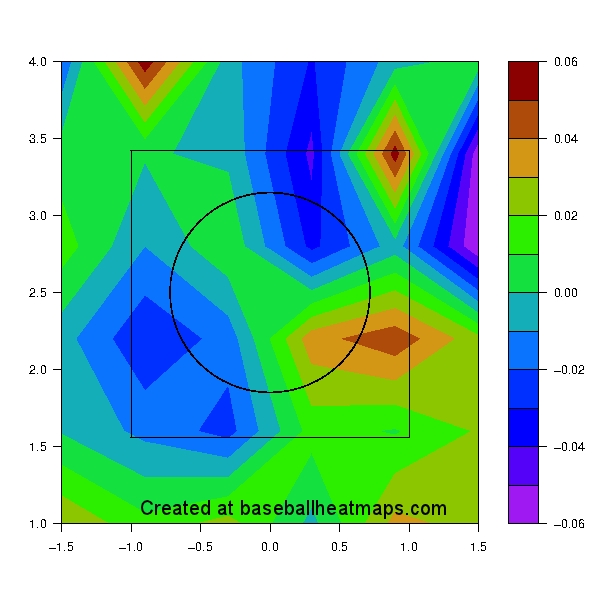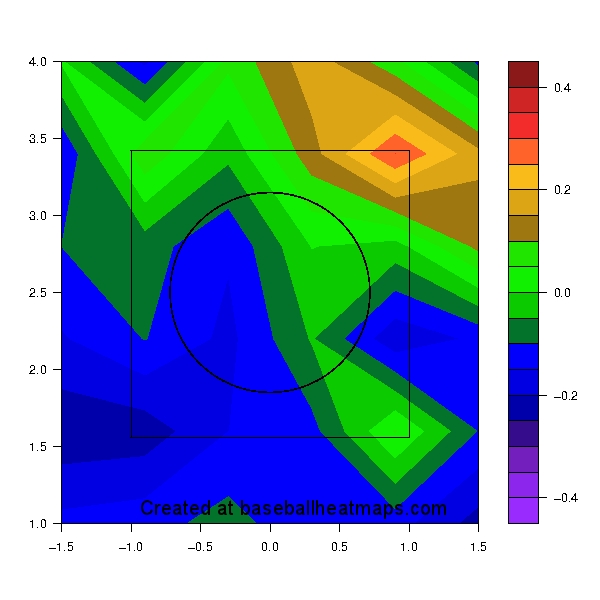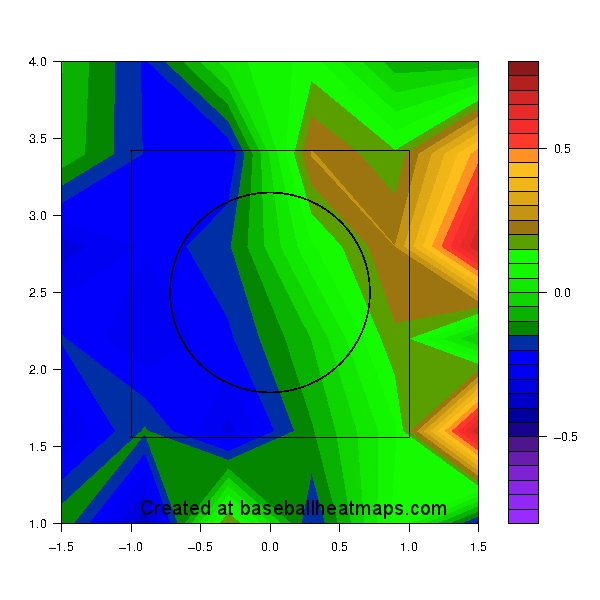Why Does Dustin Ackley Strike Out So Much?
In most facets of the game, Dustin Ackley has been exactly as advertised. He was drafted as a disciplined hitter who made a lot of contact, hit the ball into the gaps, and utilized his speed to rack up extra base hits. We expected that he’d draw his fair share of walks and get a bunch of doubles, and because he wouldn’t strike out that much, he’d hit for a high enough average to be a good offensive player even without a ton of power.
Guy who draws walks? Yep, he’s at 10.5% BB% in the big leagues.
Gap power? Yeah, he’s got 28 doubles and six triples in 147 career games.
Good contact rate? He’s at 84.1%, well above the league average of 80%.
Lack of strikeouts leading to high batting average? Uhh, no.
Ackley’s career major league strikeout rate is 21.1%, higher than the 19.1% league average during his time in the big leagues, and his batting average is just .263. Batting average isn’t a great way to evaluate a hitter, but mid-level power guys generally need to hit for a higher average to offset the lack of bombs. Ackley is just not getting as many base hits as was expected, and it’s pretty much entirely due to the fact that he’s striking out far more than he has previously.
In college, Ackley hardly ever struck out. Same thing in the minors, when his strikeout rate was about 13%. In the Majors, though, it’s a different story – for reference, Ackley’s K% this year is essentially the same as Miguel Olivo’s. So, what’s the deal?
First, let’s deal with the fact that this is a bit of an odd phenomenon. Guys who hit for as much contact as Ackley don’t strike out this often.
Remember how we said his career contact rate was 84.1%? To come up with something like an expected K%, I pulled all hitters who have at least 500 PA since the start of the 2009 season, and then filtered for players with contact rates between 83%-85%. This gives us 52 players and nearly 64,000 plate appearances, so we’re dealing with a pretty good sample size here. As a group, these 52 hitters made contact at the same 84.1% rate as Ackley, yet they only struck out in 15.2% of their plate appearances. In fact, Ackley has the highest K% of the entire group, and former Mariner Josh Wilson is the only other guy over 20%.
The relationship between contact rate and strikeout rate is not surprisingly quite high. In fact, the correlation between the two is -0.9, which gives you an r squared of 0.81, meaning that you can explain 81% of the variance in strikeout rate simply through a player’s contact rate. It is, by far, the strongest determinant of how often a player will strikeout. This isn’t news to anyone who has watched baseball very long, of course, but it’s worth a reminder – guys who make contact more often than most strike out less often than most. At least, guys not named Dustin Ackley.
So, the first takeaway from this is that we probably shouldn’t expect Ackley to keep striking out this often. Contact rate is the skill that drives strikeout rate, not the other way around, so Ackley has demonstrated the necessary ability to post an above average K%. That’s the number that’s likely to regress, not the contact rate. Consider that good news – Ackley’s current K% is probably unsustainable given his overall skills at the plate, and will almost certainly improve as time goes on.
That doesn’t really answer the question of why he’s been striking out so much, though, or what he needs to improve upon in order to cut down on the strikeouts. For that, let’s turn back to our trusty friend The Heat Map, which will show us where Ackley is good at hitting the ball and where he’s not.
This plot compares the run value Ackley creates on different pitch locations to the league average hitter, with warmer colors (red, yellow, etc…) being good zones and colder colors (blue, purple) being problem areas.
Ackley is really good against pitches down and in, which is the sweet spot for a lot of left-handed batters. He’s less good against pitches down and away, but that’s pretty common as well, and not a lot of pitchers can consistently locate in that part of the strike zone, so it’s not a huge issue. The real issue, though, is that middle-up area – Dustin Ackley has consistently been beaten with high fastballs, and he knows it. In today’s News Tribune, he tells Larry LaRue:
“Over time, you see the adjustments pitchers are making on you. I see more high fastballs with two strikes. Sometimes they come in hard with two strikes,” Ackley said.
“Not every time, and not every pitcher. That would make it an easier adjustment on my part. Pitchers are smart. They don’t approach you the same way each time.
“I’ve chased their pitches too often.”
The data supports Ackley’s observation – he’s seeing a lot of high hard fastballs with two strikes, and he’s not hitting them all that often. The good news is that he’s aware of this issue, and he’s a talented enough hitter to do something about it. Realistically, he probably just needs to stop swinging at so many pitches up in the zone, because that’s not an area that is consistently called strikes, and it’s an area other hitters generally let pitches go by. Here’s Ackley’s swing plots versus league average, broken out by left-handed and right-handed pitchers.
Vs RHP:
Vs LHP:
Ackley hardly ever swings at pitches on the outer half of the plate, especially if they’re coming from a left-handed pitcher. That’s just a zone he leaves alone, because he knows it’s a weak area for him. But look at his swing rates on pitches middle-up and middle-in – he swings at those pitches a lot, and with the exception of the ones on the inner corner, he doesn’t make very good contact with those pitches.
This is the adjustment Ackley needs to make in order to get his strikeout rate and his contact rate to line-up. Once he closes that hole, and stops getting beaten on high fastballs so often, his strikeout rate will go down and his performance will go up. The good news is that he’s shown the discipline, contact skills, and gap power that should make him a quality hitter and a valuable piece to build around. He’s just a weak spot that pitchers are currently exploiting, and it’s undermining his overall performance at the moment. I wouldn’t call this a long term concern, especially given that he has identified the issue on his own and is working to fix it – in fact, I’d be encouraged that this probably won’t last that much longer.
Don’t be disappointed with Dustin Ackley. He’s still the cornerstone player that he looked like a year ago. He just isn’t a finished product quite yet.
Comments
28 Responses to “Why Does Dustin Ackley Strike Out So Much?”
Leave a Reply
You must be logged in to post a comment.




“Guys who hit for as much contact as Ackley does don’t strike out this often.”
Not trying to be difficult, you just might want to fix that.
Much thanks for this. I was wondering what the issue was. Sounds like scouts rewrote the book on him over the off-season, but he seems like cerebral enough of a hitter to make adjustments. Coupled with his tendency to start slow, I’m confident that his second half is going to pick up quite a bit.
Not going to lie – I saw the headline and Dave’s name attached to the post and I braced myself for another “yah, that guy on our team you were banking on? He isn’t any good…” post.
Obviously feeling relieved. Still reeling from the Justin Smoak post.
Damn statistically reinforced evaluations … they are killing our dreams.
The relationship between contact rate and strikeout rate is not surprisingly quite high. In fact, the correlation between the two is -0.9, which gives you an r squared of 0.81, meaning that you can explain 81% of the variance in strikeout rate simply through a player’s contact rate.
!!!!!
When I was in research, you hit the mother lode at r squared of .5 or .6….you just don’t see things so clearly linked—of if you do, they’re ABCs of the field.
Does he also need to use his good contact skills to foul off pitches on the outer half more?
It seems, subjectively in individual games I’ve watched, like he is getting a lot of called strikes on the outer edge. I.e. it seems like his strike zone judgement for what the actual textbook zone is, is correct… but umpires are calling a wider strike zone than Ackley is expecting. So he lays off what he thinks is a ball outside and then looks surprised to see it called a strike.
What would be the best way on heatmaps, fangraphs, etc. to test this theory?
Excellent article for me!
Ackley has baffled me. The K’s, the constant groundouts to 2nd.
Having answers and a proposed solution puts me at ease.
The best part is that it’s all convincing, because of the very solid process you took to get there. Love it.
I was thinking about this earlier this morning before the article was up, and this basically confirmed what I thought was the problem with Ackley. He hasn’t been swinging at the “lefty strike”, and when he does he doesn’t make good contact, so pitchers are living on that part of the plate against him. Once he learns how to fight that pitch off, and even make decent contact against it, then he’ll start seeing more pitches on the inner part of the plate.
Glad to see that it’s not time to start freaking out about a core piece of the future, except maybe Smoak. But that’s for a different post.
Not that I was overly worried before but this article eases my concerns about Ackley a bit. It is good to see that he recognizes where he needs to get better. Now if he can execute on that it would be awesome.
I feel like Ackley’s unwillingness to swing at pitches just off the plate outside has cost him some strikeouts looking. He’s better at judging those than the ump, so with two strikes he needs to foul those off. The other day he stroked a double off one of those with two strikes…just off the plate and up. I took that as a good sign.
Great article.
I believe it’s been shown that making contact with pitches out of the zone leads to a mostly weak contact and outs. So swinging at “balls that are being called strikes”, even if you are a good contact guy, is probably not a good approach.
Just make these heat chart posts an ongoing series. It’s awesome.
So swinging at “balls that are being called strikes”, even if you are a good contact guy, is probably not a good approach.
Well, if they’re being called strikes, not much you can do about it except learn how to handle them.
(And agreed about the heat charts! Zowie!)
Have the mechanics of his swing changed from last year? It seems he is pulling his head up more than he did last year.
If the heatgraph could have a correlating view of Ackley’s head/eyes when he makes contact vs. when he doesn’t – we would have a complete picture.
I have no complaints with the picture provided by the way … it is great information and a real nice article, Dave.
Ackley tends to pull his head. When he keeps his head on the ball – he makes more consistent contact. This is not earth shattering news for any hitter.
The sequence of his front foot landing and his head ‘pulling’ are mechanical flaws that I am sure he is working on and I am sure he will eventually resolve and become more consistent with.
He has a great swing and a quick bat and his contact rate should improve when he works into hitters counts and does what comes naturally, while remaining mechanically sound throughout the entire swing.
In general this is true but with two strikes you have to swing at the ones that might graze the black and get you called out. I’ve seen too many of Ackley’s AB’s end with him called out on a pitch two inches off the outside corner. It’s a reachable ball but one he does (and should) normally lay off of. Umps tend to set up on the catcher’s right, so they don’t see pitches in that location well.
I’m afraid he’s having more than one single hole and his AB’s are becoming awful in several aspects. I’d say he looks a bit confused too and quite away from being able to fix his problems right now. But he’s certainly a smart ballpalyer with lot of talent, thus I’m expecting for his adjustments during this season. Still I remain of the opinion that the loads of his un-natural defensive position is not helping him to focus on batting first.
So swinging at “balls that are being called strikes”, even if you are a good contact guy, is probably not a good approach.
If they’re being ‘called strikes’, is it not safe to say they are, in fact, strikes?
If they’re being called strikes all the time, then I agree with you. If it’s only a few bad umps, or if we’re talking about one particular game, then I don’t. That’s when the manager needs to go argue the strike zone and get tossed. 😀
Yeah, I can’t argue against having to change behavior somewhat when you’re down two strikes.
Hehe, okay. How about “strikes that should have been called balls? 😉
wasn’t trying to be flippant, just trying to understand a bit better:) thank you!!
Actually you made me realize I wasn’t phrasing my argument as clearly/unambiguously as I should have – so thank YOU.
Great work. I normally tune out analysis involving swing/pitch charts because at first glance they look confusing/intimidating, but you explained everything in simple, easy to understand language and I was surprised how easy it was to follow. I feel smarter than I did 5 minutes ago. Thanks for that.
Finding out Dustin Ackley has a similar K% as Miguel Olivo is like finding out Key Lime Pie tastes the same as dog crap.
That one surprised me– although I have to admit, while “watching” on Gameday when I’m working I remember a LOT of “Called Strike, Out(s)” at the end of Ackley at bats lately.
Is this maybe the way Ackley goes about “making adjustments”… I remember his first month in the minors he was awful, and then all of a sudden he was making contact with everything a couple months into the season. Maybe he’s a watcher/thinker when it comes to developing new strategies, and just needs to internalize his solutions first before he’s able to utilize them?
I appreciate the work as well Dave. I remember this article I read last August which showed Ackley’s heat maps after 150 PAs. It is interesting to take a look at what he was doing then versus what he is doing now. For the first couple months last year, Ackley was crushing up and in and not missing pitches in the middle of the plate.
Here is the link:
http://onswipe.com/baseballanalytics/#!/entry/ackley-owns-the-strike-zone-baseball-analytics-blog,4f3f052ef8a8ba2d23006e2b/1
Dave – that data on the group with similar contact rates is interesting. I wonder if it might be even more interesting to group players in that family by number of ML seasons played (or maybe career ML AB). It seems like Ackley and the other young players suffer just a bit from learning on-the-fly at the knees of ML pitching. It’d be interesting to see if the data bore that out.
Good article. And that heat map tool is something!
Great post Dave. I’d like to see Ackley lay off the up and in pitch or foul it off and would like to see him drive the outside pitch to left field. Once he figures himself out, he will scintillate.
Not only is Ackly striking out that the same rate as Olivo, his ISO (.114) is the same as Ichiro (.116), that isn’t a good combination.
I don’t know if anybody has noticed that Kyle Seager’s walk rate is taking steroids.
April 1.4 BB%
May 8.6 BB%
June 19.4%
At the same time Saunders’s walk rate is going down but not as significantly. But I am not too concerned about that, if your hitting the ball like Saunders is now, why not swing the bat? Hell of a home run tonight. I’d call the distance Branyanesque the only thing missing was the loft.
It’s good to see these guys taking walks when they’re given. Saunders has been doing it all year.
Seager continues to surprise and impress me.
If/When any two of Ackley/Montero/Smoak figure out how to consistently turn it around, I think we’ll have a darn good core of young hitters – and Jaso isn’t exactly old either (if Wedge will only play him).